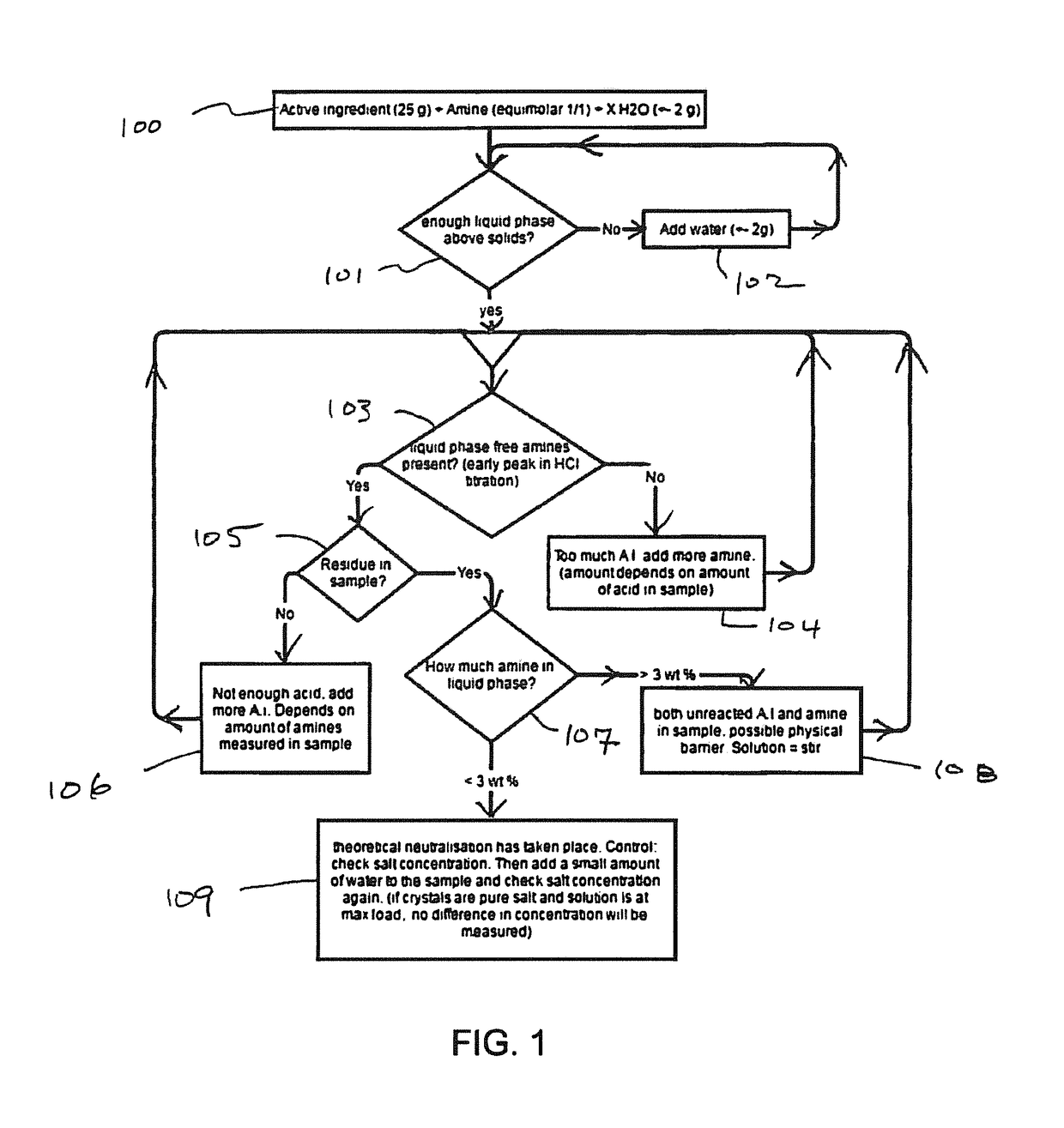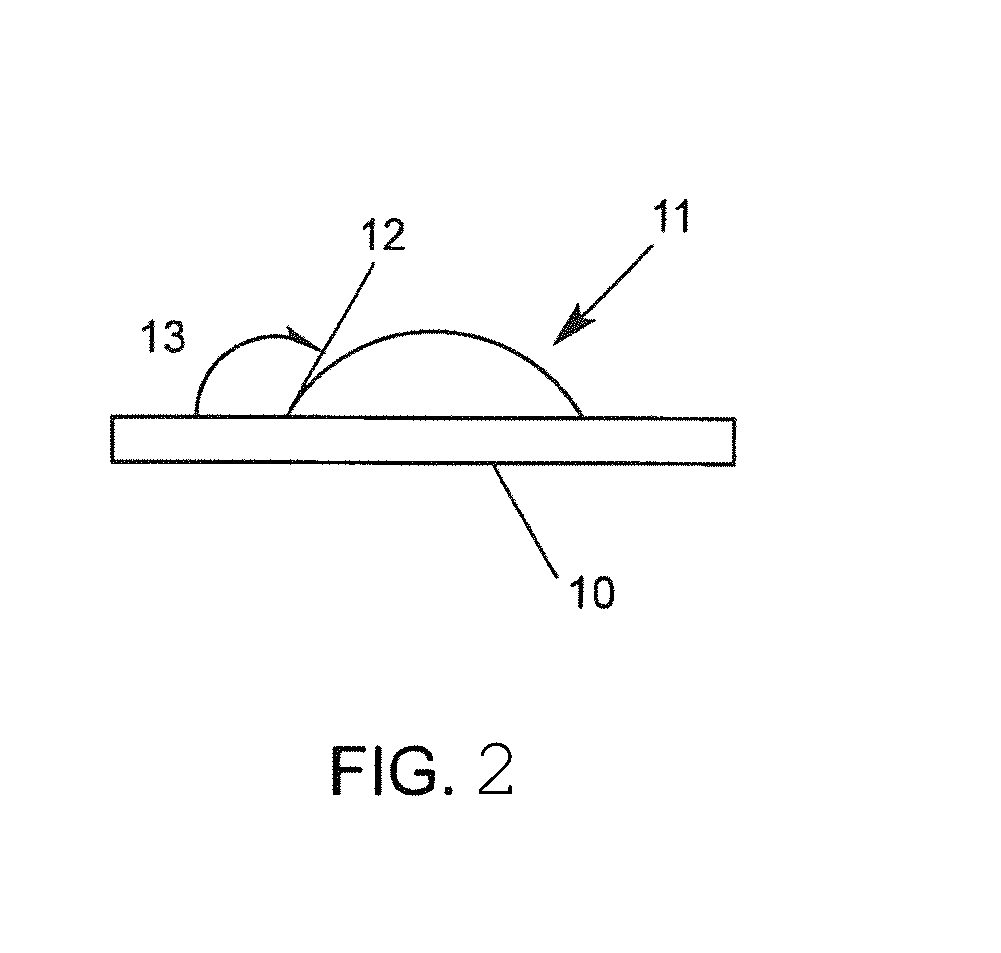Amine salts of carboxylic acid herbicides
a carboxylic acid and herbicide technology, applied in the field of herbicides, can solve the problems of damage to sensitive crops, lack of one or more desirable properties, and unsatisfactory results
- Summary
- Abstract
- Description
- Claims
- Application Information
AI Technical Summary
Benefits of technology
Problems solved by technology
Method used
Image
Examples
example 1
Preparation of High-Loaded Dicamba Amine Salt Solutions
[0086]25.02 g of dicamba herbicide was mixed with 4.16 g of 1,2-DAP and 5.88 g of water. The ingredients were shaken for a minimum of 24 hours at room temperature (20° C.) to obtain an oversaturated salt solution (with precipitated salt crystals). Theoretically, 1 mol of dicamba can be neutralized using 0.5 mol of 1,2-DAP. Water was gradually added until all the salt crystals were dissolved to form a maximum loaded clear solution. The loading of the active ingredient was determined based on the amine content by HCl titration and the water content by Karl-Fischer.
[0087]Maximum loading of 803.2 g ae / L herbicide and 365.9 g amine / L were measured. The loadings are in line with a control salt made of DGA with dicamba.
[0088]Similar experiments were performed for other amines in combination with dicamba. The other amines and the results are shown in Table 1.
TABLE 1Maximum Loadings of Dicamba Amine SaltsAmineMax LoadName / StructureAbbrev...
example 2
Preparation of High-Loaded 2,4-D Amine Salt Solutions
[0089]Using the same methodology as described in Example 1, high-loaded 2,4-D salt solutions were prepared. The amines used and the results are shown in Table 2.
TABLE 2Maximum loadings of 2,4-D Amine SaltsMax LoadAmineg ae / Lamine g / LDMA*936.1264.4DMAPA863.5210.6MMEA774.3302.5DMAE624.7316.9MIBA497.8183.5Cbase*195.0315.6*Control
[0090]As seen from Table 2, several 2,4-D amine salts have maximum loads that are comparable with the DMA control salt, while all were higher than the Cbase control salt.
example 3
[0091]Preparation of Amine Salt Solutions with Good Viscosity and Wetting Properties
[0092]Several amine herbicide formulations were prepared as described above in Examples 1 and 2. The viscosity of various formulations was measured using a Brookfield viscometer with nr.87 spindle at 20° C. Wettability was measured by visually measuring the contact angle after placing a standard droplet on a parafilm layer (hydrophobic). The results of dicamba amine salts are reported in Table 3.
TABLE 3Viscosity and Wettability of Dicamba Amine Salt ConcentratesViscosityWettingAmine(mPa)Angle (°)DMA*58.8135MMEA3,967.0120DGA*562.5120DMAE184.4115DMAPA1,791.01201,2-DAP218.0105MIBA46.1130Cbase13.5115*Control
[0093]For dicamba, the DMA salt can be used as reference, since this is the salt used in BANVEL (a commercial product). From Table 3, it can be seen that the amine salts are defined by having relatively similar wetting properties, but vastly different viscosity properties.
[0094]Table 4 contains viscos...
PUM
| Property | Measurement | Unit |
|---|---|---|
| Mass | aaaaa | aaaaa |
| Mass | aaaaa | aaaaa |
| Mass | aaaaa | aaaaa |
Abstract
Description
Claims
Application Information
 Login to View More
Login to View More - R&D
- Intellectual Property
- Life Sciences
- Materials
- Tech Scout
- Unparalleled Data Quality
- Higher Quality Content
- 60% Fewer Hallucinations
Browse by: Latest US Patents, China's latest patents, Technical Efficacy Thesaurus, Application Domain, Technology Topic, Popular Technical Reports.
© 2025 PatSnap. All rights reserved.Legal|Privacy policy|Modern Slavery Act Transparency Statement|Sitemap|About US| Contact US: help@patsnap.com



